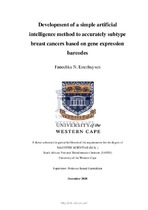| dc.description.abstract | INTRODUCTION:
Breast cancer is a highly heterogeneous disease. The complexity of achieving an accurate diagnosis and an effective treatment regimen lies within this heterogeneity. Subtypes of the disease are not simply molecular, i.e. hormone receptor over-expression or absence, but the tumour itself is heterogeneous in terms of tissue of origin, metastases, and histopathological variability. Accurate tumour classification vastly improves treatment decisions, patient outcomes and 5-year survival rates. Gene expression studies aided by transcriptomic technologies such as microarrays and next-generation sequencing (e.g. RNA-Sequencing) have aided oncology researcher and clinician understanding of the complex molecular portraits of malignant breast tumours. Mechanisms governing cancers, which include tumorigenesis, gene fusions, gene over-expression and suppression, cellular process and pathway involvementinvolvement, have been elucidated through comprehensive analyses of the cancer transcriptome. Over the past 20 years, gene expression signatures, discovered with both microarray and RNA-Seq have reached clinical and commercial application through the development of tests such as Mammaprint®, OncotypeDX®, and FoundationOne® CDx, all which focus on chemotherapy sensitivity, prediction of cancer recurrence, and tumour mutational level.
The Gene Expression Barcode (GExB) algorithm was developed to allow for easy interpretation and integration of microarray data through data normalization with frozen RMA (fRMA) preprocessing and conversion of relative gene expression to a sequence of 1's and 0's. Unfortunately, the algorithm has not yet been developed for RNA-Seq data. However, implementation of the GExB with feature-selection would contribute to a machine-learning based robust breast cancer and subtype classifier.
METHODOLOGY:
For microarray data, we applied the GExB algorithm to generate barcodes for normal breast and breast tumour samples. A two-class classifier for malignancy was developed through feature-selection on barcoded samples by selecting for genes with 85% stable absence or presence within a tissue type, and differentially stable between tissues. A multi-class feature-selection method was employed to identify genes with variable expression in one subtype, but 80% stable absence or presence in all other subtypes, i.e. 80% in n-1 subtypes.
For RNA-Seq data, a barcoding method needed to be developed which could mimic the GExB algorithm for microarray data. A z-score-to-barcode method was implemented and differential gene expression analysis with selection of the top 100 genes as informative features for classification purposes.
The accuracy and discriminatory capability of both microarray-based gene signatures and the RNA-Seq-based gene signatures was assessed through unsupervised and supervised machine-learning algorithms, i.e., K-means and Hierarchical clustering, as well as binary and multi-class Support Vector Machine (SVM) implementations.
RESULTS:
The GExB-FS method for microarray data yielded an 85-probe and 346-probe informative set for two-class and multi-class classifiers, respectively. The two-class classifier predicted samples as either normal or malignant with 100% accuracy and the multi-class classifier predicted molecular subtype with 96.5% accuracy with SVM.
Combining RNA-Seq DE analysis for feature-selection with the z-score-to-barcode method, resulted in a two-class classifier for malignancy, and a multi-class classifier for normal-from-healthy, normal-adjacent-tumour (from cancer patients), and breast tumour samples with 100% accuracy. Most notably, a normal-adjacent-tumour gene expression signature emerged, which differentiated it from normal breast tissues in healthy individuals.
CONCLUSION: A potentially novel method for microarray and RNA-Seq data transformation, feature selection and classifier development was established. The universal application of the microarray signatures and validity of the z-score-to-barcode method was proven with 95% accurate classification of RNA-Seq barcoded samples with a microarray discovered gene expression signature. The results from this comprehensive study into the discovery of robust gene expression signatures holds immense potential for further R&F towards implementation at the clinical endpoint, and translation to simpler and cost-effective laboratory methods such as qtPCR-based tests. | en_US |

